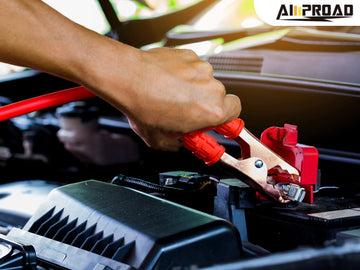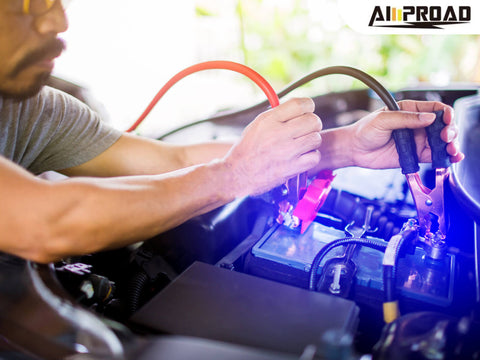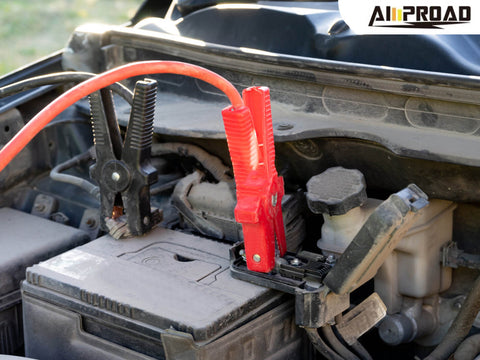
Battery issues need not leave you stranded once you master the fundamentals of jump-starting. Through proper technique and the right equipment - whether traditional jumper cables or modern portable jump starters - reviving a dead battery becomes a manageable task. Understanding the correct steps and safety protocols transforms this roadside challenge into a straightforward process, keeping you moving without unnecessary delays.
Your car won't start – dead battery blues. No worries, we've got your back with this comprehensive guide on how to boost a car. Jumping a dead battery may seem straightforward, but many folks, especially men, can find themselves scratching their heads. Positive on negative? Grounding the positive cable where? Is the red cable negative?
To save you from looking perplexed and safeguard you from a shocking experience (literally), this article provides a thorough multimedia breakdown on jumpstarting a dead car battery. But, hold on...
Is the battery truly the culprit? Before diving into jumpstarting when your car won’t start, ensure the battery is the issue. If you hear the engine cranking when you turn the key, a dead battery isn't the problem. But if your car remains silent, it's time to explore jumpstarting as your road to revival.
How to Jump Starting Your Car with Jump Starter?
Jump-starting your vehicle's battery is a simple yet essential skill every driver should have in their toolkit. Whether you're dealing with a dead battery in your driveway or helping out a stranded fellow driver, a portable jump starter, also known as a jump box or car battery jump starter, can be your saving grace. In this comprehensive guide, we'll walk you through the step-by-step process of using a portable car jump starter, exploring the best portable jump starters, and understanding the must-have features of a reliable portable battery charger for cars.

Prepare the Jump Starter:
Before diving into the jump-starting process, ensure your portable jump starter is charged and in optimal condition. Check the LED indicators to confirm the battery level, ensuring it's ready for action when needed.
Position the Vehicles:
Park the operational vehicle close to the one with the dead battery, ensuring a safe distance between them. They should not be touching, but proximity is crucial for the jumper cables to reach both batteries effectively.
Identify the Battery Terminals:
Familiarize yourself with the battery terminals on both vehicles. The positive terminal is typically marked in red, while the negative terminal is black. Understanding these terminals is vital for a safe and effective jump-start.
Attach the Jumper Cables:
Connect the red clamp of the jumper cable to the positive terminal of the dead battery. Next, attach the other red clamp to the positive terminal of the fully operational battery.
Connect the Black Clamp:
Take the black clamp of the jumper cable and attach it to the negative terminal of the fully operational battery. However, instead of connecting the other black clamp directly to the negative terminal of the dead battery, find an unpainted metal surface in its engine bay. This step prevents sparks near the potentially hydrogen-emitting battery.
Activate the Jump Starter:
Switch on the jump starter and allow a few moments for the transfer of power to take place. The portable jump starter acts as a bridge, supplying the necessary power to kick-start the dead battery.
Start the Vehicle:
Attempt to start the vehicle with the dead battery. If successful, let it run for a few minutes to allow the alternator to recharge the battery.
Disconnect the Jumper Cables:
Carefully remove the jumper cables in reverse order to the way they were connected: black from the previously dead vehicle, black from the functioning vehicle, red from the functioning vehicle, and finally, red from the previously dead vehicle.
Remember, it's crucial to consult your vehicle's manual for specific instructions and safety precautions. If the jump-starting process fails, there may be underlying issues with the battery or electrical system, and seeking professional assistance becomes imperative. Portable jumper cables and a reliable portable car battery charger nearby can be invaluable tools, especially in emergency situations. Ensure your portable jump starter is always charged, and consider having a jump starter near me for peace of mind on the road. Mastering the art of jump-starting is a must-have skill that can save you from being stranded and provide assistance to others in need.

How to Choose the Best Jump Starter?
Choosing the right jump starter is a critical decision for any vehicle owner, ensuring a swift response to unexpected battery issues. We will explore the key considerations to help you select the best jump starter for your needs.
Power capacity is a primary factor, with options ranging from traditional jump starters to compact portable packs. Prioritize portability, opting for a lightweight and easy-to-store solution. Safety features like reverse polarity protection and user-friendly designs contribute to a hassle-free experience during emergencies.
Look for additional functionalities, such as built-in flashlights, USB ports, and air compressors, enhancing the versatility of your jump starter. Amproad emerges as a cost-effective yet quality supplier in this market, offering dependable solutions without compromising your budget.
By choosing Amproad, you gain access to affordable irock battery booster with essential features, ensuring you have a reliable tool when facing unexpected battery challenges. Make an informed decision, and equip yourself with a trustworthy solution that keeps you moving forward on the road.
Should You Use a Jump Starter or a Booster Pack?
Deciding between a jump starter and a booster pack hinges on your unique needs and preferences, with each device offering distinct advantages. Both tools share the common goal of jump-starting a vehicle, yet they diverge in terms of features and capabilities.
A battery jump starters are compact and portable device, meticulously designed for the singular purpose of jump-starting vehicles. Typically encasing a battery and equipped with jumper cables, it often incorporates additional conveniences such as a built-in flashlight or USB ports. Its streamlined design caters specifically to the exigencies of vehicle emergencies, and its compact nature renders it easily storable in your vehicle.
Contrastingly, a booster pack, also referred to as a jump box, encompasses a more comprehensive power supply unit. Frequently boasting a larger battery capacity, it goes beyond the confines of jump-starting. These versatile tools often include outlets and USB ports, transforming them into multi-functional power sources suitable for a spectrum of applications, from charging devices to powering small appliances.
The decision between a portable car jump box and a booster pack is contingent on your priorities. If your primary requirement is a reliable tool for vehicle jump-starting during emergencies, coupled with an emphasis on portability, the jump starter stands out as a straightforward and compact choice. Its purpose-driven design simplifies the jump-starting process, making it an ideal companion for unforeseen vehicle battery issues.
Conversely, if your needs extend beyond a singular focus on jump-starting, and you value a versatile power source with broader applications, the booster pack emerges as a fitting solution. While potentially bulkier due to its increased battery capacity and additional features, its versatility allows it to serve various functions, making it an asset not just for vehicle emergencies but also for camping, outdoor activities, and powering electronic devices.

Consider factors such as ease of use, portability, and budget when making your decision. Ultimately, choose the tool that aligns with your intended use and provides the features that matter most to you, ensuring you have a reliable solution that meets your needs in various scenarios.
Brief on Car Jump Starter VS Jumper Cables
When confronted with a vehicle sporting a dead battery, the decision between a car jump starter and jumper cables becomes a nuanced consideration of convenience, self-sufficiency, and ease of application.
Car battery jumper emerges as autonomous devices, featuring their own rechargeable battery. Their standout feature lies in the independence they offer from external vehicles, making them a portable and self-sufficient solution. With added functionalities such as built-in flashlights and USB ports, car jumper starter brings an extra layer of versatility and safety features to the table. Their user-friendly design further enhances their appeal, providing a reliable option for a variety of scenarios, including remote locations where access to another vehicle may be limited.
Conversely, jumper cables rely on the availability of a second vehicle with a functional battery. While they fulfill the fundamental purpose of transferring power to a dead battery, they lack the stand-alone capability inherent in car jump starters. So, it's crucial to know how to use jumper cables Proper connection procedures and knowledge are imperative when using jumper cables to prevent potential accidents, adding a layer of complexity compared to the straightforward application of car jump starters.
The crux of the decision-making process revolves around considerations such as portability, self-sufficiency, and the immediate availability of another vehicle. Car jump starters present a compelling choice for those seeking an independent and versatile solution, adaptable to various situations. On the flip side, jumper cables remain a traditional yet straightforward alternative, contingent on the proximity of a secondary vehicle. Tailoring your choice to your specific needs ensures the acquisition of a reliable tool poised to jump-start your vehicle whenever the need arises.


